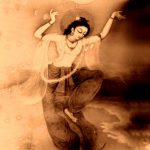by Srila B.R. Sridhar Maharaja
(The following Bengali lecture was given by Srila Sridhara Maharaja at the Sarasvata Sravana Sadan, at 7:00pm on 6th June, 1937)
The scriptural texts are present in this world in order to discipline us. Observing that our non-devotional sense-perception and mental state are extremely difficult to suppress, the sastra keeps them regulated and properly disciplined, without which we will never attain auspiciousness. From this perspective, the sastra is most qualified – the process of disciplining has been termed as ‘sastra’.
Within this world, these sastras are principally followed in two ways. The first kind of sastra appears from the imagination of great men – these can help us attain some momentary auspiciousness. The second kind of sastra is called srauta-sastra. They have descended on this earth through the srauta-parampara (the disciplic succession of hearing) as the pure transcendental flow of knowledge for bestowing auspiciousness to the world at large.
The books born out of the imagination of men that have established themselves as sastra are based on the path of the avaroha-marga (ascending knowledge), or the realm of worldly experience – this deals with dharma, or the performance of good deeds to earn pious credits; artha, or the perfect attainment of false self-interests; kama, or the total fulfillment of all material desires, and moksha, or self-destruction as a result of pseudo-renunciation stemming from developing distaste for the abovementioned types of gratification. Whatever is conceived and established based on the aforementioned self-interests are thus categorised as the avaroha-marga and are based upon mutual convenience and inconvenience. They provide some information on temporary, relief and conveniences in this world or the next, but they cannot bestow supreme benefit or true auspiciousness. Disciplinary statements born out of the ordinary experiences of the limited senses that are characteristically filled with anxieties pertaining to this finite world are subject to the fourfold defects of bhrama, pramada, vipralipsa and karanapatava, and can never benefit the atma. How is it possible to bring about eternal benefit to the atma when one is afflicted by non-spiritual or material thinking?
Yet the second kind of sastra has descended through the medium of srauta (hearing) in the disciplic succession of mahajanas from the infinite infallible Vaikuntha-loka as the sermons of Bhagavan, and is devoid of the fourfold defects discussed previously. Since it is coming from Bhagavan, who is purna-satya-svarupa (the personification of complete truth), jnana-svarupa (the personification of transcendental knowledge) and ananda-svarupa (the personification of bliss) through the disciplic succession of His dear unalloyed devotees, it is capable of revealing the true path of auspiciousness to the jivas who are constitutionally the Lord’s eternal servants. But this srauta-sastra has not manifested in equal proportion in all parts of the world.Depending on time, place, circumstances, mentality etc. they have appeared differently, or due to various understandings of their meaning. The fact that Bharata-varsa is the forerunner and teacher on spiritual topics is a universal truth. For this reason the extent to which the complete truth manifests and reveals itself in Bharata is not possible anywhere else. There is no trace of any self-promotion in this declaration. This is now accepted by all.
Just as all categories of worldly elements can be scientifically evaluated, similarly in the world of dharma, the most qualified of people can evaluate differences in the sastra. Perhaps ordinary people can distinguish between glass and diamonds, but apart from a jeweller no one can understand the qualities found amongst different gradations of elements within diamonds. Similarly, men who are most experienced in the world of dharma can evaluate the gradations of the sastra by comparing them with proper standards of evaluation.
Although there are more than a thousand philosophies and ideologies known as ‘dharma’ that are present in this world, they are not all of equal value. Hence the saying, Yata mata tata patha (“All paths lead to the same goal”) is worth nothing. Again, there is no rule in the world of supreme transcendence that the religion followed by the majority of the population must be considered the best. There was a time when the Buddhist religion was very influential in the world and was practiced by a large number of people – but it cannot be said to be the best system of dharma. Our understanding of dharma cannot be based upon the strength of public opinion. One must properly understand the symptoms of genuine dharma and accordingly learn to perceive what is not dharma. One needs to analyse all the constituents, the lack of which leads to adharma and the addition of which leads to the preservation of dharma. Naming everything as equal and classifying them as the same is merely a symptom of ignorance. One should minutely judge the unique characteristics of everything.
Of the numerous ideologies present in the world that go by the name of dharma, some of them are steps towards bhagavata-dharma, while some are merely perverted thoughts. When we are lazy or we lack faith in proper analysis and discrimination, then we become negligent and declare, “Whatever’s there is all fine! There is no necessity to create any disturbance.”
Even for ordinary things like politics etc. that are fleeting in nature and give momentary pleasure, we are unable to simply accept them blindly without spending so much of our energy going through various types of analysis. But when it comes to dharma we hastily come to a conclusion without thinking and deliberating upon it! Religious people never compromise in this manner. When even worldly affairs cannot be properly understood without minutely analysing them, then how can it be proper that a spiritual path can be accepted without discrimination?
The srauta-sastras neglect worldly experiences and by frustrating such temporary endeavors, they descend from above out of their mercy for the jivas. When we come under the influence of selfishness we develop a perception of worldly objects. It is possible that different types of people with different levels of intellectual capacity can have various understandings of religious scriptures based upon their individual selfish propensities. Like us, it is natural even for tiny creatures like insects, flies etc. to have self-fulfilling ideas on material objects. Therefore it is not entirely unnatural even for srauta-sastras to have different meanings based on individual selfishness.
Only those things that explain the complete truth are capable of fully satisfying our real or eternal necessity. That truth descends through the medium of sruti from a realm beyond our senses and spiritually penetrates our aural reception, and through this process it nullifies all sensory defects. The senses, being overwhelmed by false perceptions, were in a state of anxiety, but now those false perceptions are eradicated and are substituted with real knowledge. Frustrating the perception developed from worldly experience gathered by people, this knowledge descends on earth through the medium of aural disciplic succession. The Vedas have descended on earth in the form of sermons of the supreme Lord. The power of our material senses is defeated by a place beyond their reach – the Vedas have descended from that arena. Therefore the proof of the Vedas is self-evident. The best of men within this world that belong to the society of Aryans accept the Vedas. Yet in several places there is criticism of the Vedas, such as when Bhagavan said:
yam imam puspitam vacam pravadanty-avipascitah veda-vada-ratah partha nanyad astiti vadinah
“O Partha, those with small intelligence misinterpret the Vedas and claim there is no divine principle in creation. Thus they glorify those statements that are pleasing to their senses.” (Gita 2.42)
kamatmanah svarga-para janma-karma-phala-pradam kriya-visesa-bahulam bhogaisvarya-gatim prati
“Because their hearts are filled with selfish desires and their goal is the higher planets, they prescribe many rituals that award higher birth, wealth and power and lead to enjoyment and opulence.” (Gita 2.43)
traigunya-visaya veda nistraigunya bhavarjuna
“The Vedas deal with subjects in the three modes of material nature. O Arjuna, become transcendental to these three modes.” (Gita 2.45)
In all these places the Vedas have been accepted. The Vedas are like a kalpataru (desire tree) or a kama-dhenu (wish-fulfilling cow). Therefore they can be interpreted from different directions such as karma (fruitive activity), jnana (speculative knowledge) or upasana (devotional worship). In Karma-kanda it is said:
rocanartha phala-srutih
“For the purpose of giving encouragement, the Vedas promise material results.” (Bhag. 11.3.46)
Thus, they instruct their followers not to restrict themselves to karma only. Again it is said:
na buddhi vedam janayed ajnanam karma-sanginam
“The wise should not disturb the minds of the ignorant who are attached to their selfish activities.” (Gita 3.26)
Here it is forbidden to withdraw the intelligence of karmis from karma. In this way, while looking for the real meaning of mutually conflicting references, in most cases they become trapped in impersonalism. The Vedas have been manifested for a very long time. Scholars understand the Vedas by means of following vyakharana (grammatical rules), nirukta (etymological interpretations) etc. This is the practice followed in the world at present. If help is taken to understand the Vedas through this method, danger is inevitable. But there is no possibility of any danger if one is dedicated to the path of amnaya parampara or guru parampara.
yasya deve parabhakti yatha deve tatha gurau tasyaite kathitam hyartham prakasante mahatanam
“Only unto those great souls who have implicit faith in both the Lord and the spiritual master are all the imports of Vedic knowledge automatically revealed.” (Svetasvatara Upanisad 6.23)
In all the statements of the sruti, following the flow of the amnaya parampara has been universally recognised. Otherwise the strength of our feelings based upon our intuitive knowledge will lead us to an impersonal conclusion.
The meaning of the Vedas is fulfilled with the help of the Dharma-sastras, or Samhitas and Puranas. The very concise Rgs or mantras in the Vedas that are left unexplained are explained in detail with proper examples in the Puranas.
itihasa-puranabhyam vedam samupabrmhayet
“Knowledge of the Itihasa and the Puranas is essential to understand the Vedas.” (Mahabharata. Adi-parva 1.267)
The Puranas are not concocted stories. The aim of the Puranas is to clearly explain in detail the meaning of the Vedas by citing practical examples. Whatever tattvas in the Vedas that have the probability of being interpreted in multiple ways have been given complete explanations through the examples found in the Puranas and their proper significance has been explained. For the people in general it is especially convenient to grasp the meaning from the Puranas as compared to the original Vedas.
Krishna Dvaipayana Vyasadeva himself has divided the Vedas and revealed them as the eighteen Puranas. Although some Puranas are named after sages like Markandeya, those specific sages have not revealed those particular Puranas. On the basis of their questions and answers, the Vedas have revealed themselves based on differences in qualification. In ancient times there were one hundred crore of slokas in these eighteen Puranas, but those have disappeared with time and only four lakhs of shlokas are still existing. The Madhyandina Sruti and the Kaumudi branch of Sama Veda have declared the Puranas as the Fifth Veda. Women, sudras and fallen brahmanas have no eligibility to read the Vedas, but the Puranas are accessible to all. They are more merciful due to the predominance of the Holy Name within them and therefore they bestow eligibility to all. Therefore the Puranas should not be considered inferior to the Vedas, rather they are more adorable to us.
These eighteen Puranas are divided into three categories – goodness, passion and ignorance. In the Brahma-vaivarta Purana it is mentioned that Visnu, Narada, Garuda, Varaha, Padma and Bhagavata are Puranas in the mode of goodness; Brahmanda, Brahma-vaivarta, Markandeya, Bhavisya, Vamana and Brahma are Puranas in the mode of passion; Matsya, Kurma, Linga, Siva, Skanda and Agni Purana are famous as being in the mode of ignorance. In the Puranas that are in mode of goodness, the greatness of Sri Hari has been primarily described. It has been discussed the most. If one wants to understand the real meaning of srauta-katha it is absolutely necessary to take shelter of those Puranas in the mode of goodness. Again, out of the six Puranas in the mode of goodness, the Bhagavata Purana is the best to be followed. Vyasadeva has conserved the essence of the Vedas as sutras in his text on Vedanta. He did this again by composing the Bhagavata explanation which is considered the essence of all the Puranas. Therefore, from this consideration, it can safely be accepted to be the purport of the Vedas. According to Sri Jiva Gosvami all the characteristics of a Purana are fully present within the Bhagavata. The true purport of the Vedas is fully preserved in it. It has neither creation nor destruction. Sometimes it unmanifests due to our misfortune. Initially, even though this Srimad Bhagavata manifested from the Supreme Lord in a minute form within the heart of Brahma, by the mercy of Narada it blossomed into its present form in the heart of Vyasa. In other Puranas such as the Garuda Purana it is said that the Bhagavata Purana is the purport of the Brahma-sutras, it is the commentary on the Gayatri-mantra, it is the purport of the Mahabharata and it is decorated with the meanings of all the Vedas. Some people have tried to include the Devi Bhagavata within the eighteen Puranas and prove that the Srimad Bhagavata was written by some modern author. Dayananda Sarasvati, Wilson etc. tell us that it was written by Vopadeva. Vopadeva belonged to the Thirteenth Century. He composed books like Hari-lila etc. based on the conclusions of the Srimad Bhagavata. For this reason he has been erroneously concluded as the author of the Bhagavata. But in his book Mukta-carita he has mentioned the name of Acarya Sridhara, the commentator on the Bhagavata. Again Madhvacarya in the Eleventh Century has utilised it as an infallible proof in the book Bhagavata-tatparya. The Stavavali collection of Sankaracarya can be understood to be written on the basis of the language and topics of the Bhagavata.
The Bhagavata has given its own introduction:
krsne sva-dhamopagate dharma-jnanadibhih saha kalau nastadrsam esa puranarko ‘dhunodita
“After Krsna returned to His abode along with religious principles, divine knowledge etc, this sun-like Purana has appeared to enlighten those who have no spiritual vision in the age of Kali.” (Bhag. 1.3.46)
The non-dual Absolute Vrajendra-nandana has Himself manifested as the Srimad Bhagavata.
nigama-kalpa-taror galitam phalam suka-mukhad amrta-drava-samyutam pibata bhagavatam rasam alayam muhur aho rasika bhuvi bhavukah
“O rasikas, relish the mature fruit of the Bhagavatam, the desire tree of the Vedas which emanated from the lips of Suka. Therefore this fruit has become even more tasteful, although its ambrosial nectar was already relishable for all, including liberated souls.” (Bhag.1.1.3)
The Srimad Bhagavata is the matured fruit of the desire tree of the Vedas – it is naturally the real purport of the Vedas. If one studies the Srimad Bhagavata along with Vedanta-sutra, one will see that the Srimad Bhagavata is the natural commentary on the Vedanta-sutra. In Vedanta the necessity of brahma-jijnasa (inquiry into Brahman) has been ascertained, and in the first sutra the Vedanta has been further explained with, janmady asya yatah and it finally concludes with, anavrttih-sabdat anavrttih sabdat. The Srimad Bhagavata begins with the verse, janmady asya yato ‘nvayad itaratas carthesv abhijnah svarat etc. and ends with the sloka, nama-sankirtanam yasya etc. In this way the explanation of each and every sutra of the Vedanta can be harmonized with proper examples and slokas from the Bhagavata and they can be elaborately understood. Within them we can observe the amazing confluence of the Vedas, kavya (poetry) and the Puranas.
sarva-vedetihasanam saram saram samuddhrtam
“It is the extraction of the quintessence of all the Vedas and the Itihasa.” (Bhag. 1.3.41)
Within this Srimad Bhagavata, the complete essence of all the Vedas and Itihasa has been preserved.
sarva-vedanta-saram hi srimad bhagavatam isyate tad-rasamrta-trptasya nanyatra syad ratih kvacit
“The Srimad Bhagavatam is accepted as the essence of all the Vedanta. One who is satiated by the rasa of this book is never attracted to anything else.” (Bhag, 12.13.5)
If one gets even a slight taste for the Srimad Bhagavata one will not have attraction for anything else. In the Bhagavata, the words, projhita-kaitava mean that it completely rejects any form of deception based on the four categories of selfish interests (dharma, artha, kama, moksa) etc. and it manifests the real object of truth.
prthivite yata katha dharma name cale bhagavata kahe taha paripurna chale
“Whatever is going on in the world in the name of religion, the Bhagavata states that it is all cheating.” (Jaiva Dharma)
The Bhagavata makes such a great claim! It requires men of strong character to listen to its non-envious truth. The potencies of all truthful elements are surrendered unto it. The endeavours of all of our material senses fail in competing with it. Again, with its very help, the Lord, who is supremely independent of all things, becomes captured within a heart laden with a service mentality. Srimad Bhagavata says that when one understands the supremely independent Lord, all the various material activities of humans become useless. Only He can reveal Himself, otherwise it is not possible to know anything simply by our personal endeavours.
na canya eko’pi ciram vicinvan
“They can never understand Him, even after studying for a great length of time.” (Bhag.10.14.29)
Without surrendering to Him, even if we search for very long time, the attempt to know about Him will be totally futile.
tasmad idam jagad asesam asat-svarupam svapnabham asta-dhisanam puru-duhkha-duhkham tvayy eva nitya-sukha-bhodha-tanav anante mayata udyad api yat sad ivavabhati
“My Lord, this temporary material world, which is like a dream and thus we are suffering the miseries of material existence, trying to enjoy this dream. It has such potency because it has emanated from you, who are the source of everything. It is all your divine energy, though when we are bewildered, we see it as something separate.” (Bhag.10.14.22)
He is the root cause comprised of sacchidananda (eternity, bliss and knowledge). The material world born through Maya cannot even touch Him. The material world is not an essential part of the Lord. In spite of the jiva being spiritual by nature, it suffers various inconveniences when it is under the shelter of Maya.
sa vai pumsam paro dharmo yato bhaktir adhoksaje ahaituky apratihata yayatma suprasidati
“The supreme dharma for all humanity is that by which man can attain to loving devotional service unto the transcendent Lord. Such devotional service must be causeless and uninterrupted, to completely satisfy the self.” (Bhag.1.2.6)
Here the path of abhideya is being shown. He is beyond all the material senses. If a human being has unalloyed, natural and unbiased devotion towards Him, all of his anarthas are completely eliminated. The atma is then situated at its most convenient position.
sreyah-srtim bhaktim udasya te vibho klisyanti ye kevala-bodha-labdhaye tesam asau klesala eva sisyate nanyad yatha sthula-tusavaghatinam
“O Lord, those who want to have a clear conception of You through their intellect find their attempts useless. Their endeavors end only in frustration, like those who try to beat rice from an empty husk.” (Bhag. 10.14.4)
The path of bhakti is the best for the human being to attain the highest and ultimate type of auspiciousness. From bhakti the fourfold perfections (dharma, artha, kama, moksa) and jnana etc. come automatically – there is no need for any separate endeavor. Whoever rejects bhakti and endeavours only to attain jnana finds that all their efforts end in failure. If one rejects the grain but uses the chaff, he will never get any rice. The end result only gives pain and exhaustion. This bhakti can only be obtained by sadhu-sanga. This is not anyone’s personal whim.
satam prasangam mama virya-samvido bhavanti hrt-karna-rasayanah kathah taj-josanad asv apavarga-vartmani sraddha ratir bhaktir anukramisyati
“In the association of devotees, discussion of My pastimes and activities is very pleasing and satisfying to the ear and the heart. By cultivating such knowledge one gradually becomes advanced on the path of liberation, and thereafter he is freed, and his attraction becomes fixed. Then real devotion and devotional service begin.” (Bhag. 3.25.25)
When one truly associates with a sadhu and continues to hear about all the qualities of the Lord, very soon respect, attachment and devotion steadily develop within him. Sometimes when one attempts to search for non-differentiated Brahman, his gross and subtle bodies are seen to be annihilated, but if one is devoid of devotion then the position one obtains is temporary and one does not gain anything permanent. Needless to say, if the results of one’s activities are not offered to the Lord, then one will not gain anything. The only necessity is love for Bhagavan. If one performs pious works he can earn some fame for a few days in this world. After, one can attain some enjoyment in the perishable celestial planets, but what does one gain staying far away from ultimate auspiciousness? The satisfaction of the sense organs such as the eyes etc. is called kama. When one comes to realise that these senses simply give pain, then one tries to attain liberation. The term mukti (liberation) does not mean self-annihilation.
muktir hitvanyatha rupam svarupena vyavastithih
“Liberation is the permanent position of the living being when he attains his constitutional form.” (Bhag. 2.10.6)
It is the awakening of the true identity of the jiva – to be rid of all other coverings.
harir hi nirgunah saksat purusah prakrteh parah sa sarva-drg upadrashta tam bhajan nirguno bhave
“Lord Hari is nirguna (beyond the modes of material nature), the Supreme Person, transcendental to material nature, the all-cognizant witness. By worshipping Him, one similarly becomes nirguna.” (Bhag.10.88.5)
The jiva also gets liberated from the modes of material nature such as goodness etc. and attains the nirguna plane when he performs bhajana of Hari, who is beyond material nature and who is Himself nirguna and the Supreme Person. Then one becomes established in his natural occupation of rendering service. It does not end merely by becoming liberated.
muktanam api siddhanam narayanaparayanah sudurlabhah prasantatma kotisv api mahamune
“O great sage, amongst millions of liberated and perfected persons, a devotee of Narayana who is most completely satisfied is very rare.” (Bhag. 6.14.5)
It is rare to fine one devotee amongst a crore of liberated souls. Mere liberation is not the ultimate aim.
salokya-sarsti-samipya-sarupyaikatvam apy uta diyamanam na grhnanti vina mat-sevanam janah
“My devotees do not accept salokya (living on the same spiritual planet), sarsti (having the same opulence), sarupya (having the same spiritual form), samipya (to be a close associate), or sayujya (oneness with me)—even if I offer these liberations—in preference to serving Me.” (Bhag. 3.29.13)
“Those who have a taste of the happiness of My service, spit at the prospect of mukti.” Only the Bhagavata explains how one cannot even be attracted to the position of Paramesthi Brahma, the position of Indra etc. in order to establish oneself in seva-rasa (the transcendental mellows of devotional service). When one regularly reads, hears and studies the Bhagavatam, then service to the Lord becomes easily attainable. Service without any personal motivation (ahaituki-seva), the process of serving the Bhagavata in various rasas such as santa, dasya etc. is described in the Bhagavata in the purest way. Amongst the various religious scriptures the position of the Srimad Bhagavata is unparalleled and topmost. The most intimate relationship with Bhagavan, who is akhila-rasamrta-murti (the emporium of rasa), is described there. Mahaprabhu has personally revealed the greatness of the Bhagavata and with the help of His own personal associates, who received Mahaprabhu’s mercy, He preached it. Now only Sri Gaudiya Matha is trying to preach the message of the Bhagavata. Where is the recipient for such great charity? Nitya-lila Pravista Om Visnupada Sri Srimad Bhaktisiddhanta Sarasvati Gosvami Thakura has endeavored to preach it on a grand scale. The charity of the Srimad Bhagavatam is the greatest gift. The one who distributes its message is bhurida (the giver of the greatest wealth). Therefore in the world of scriptures, no book is of the same stature as the Srimad Bhagavatam.
Source: http://gosai.com/writings/the-position-of-the-bhagavata-amongst-religious-scriptures










